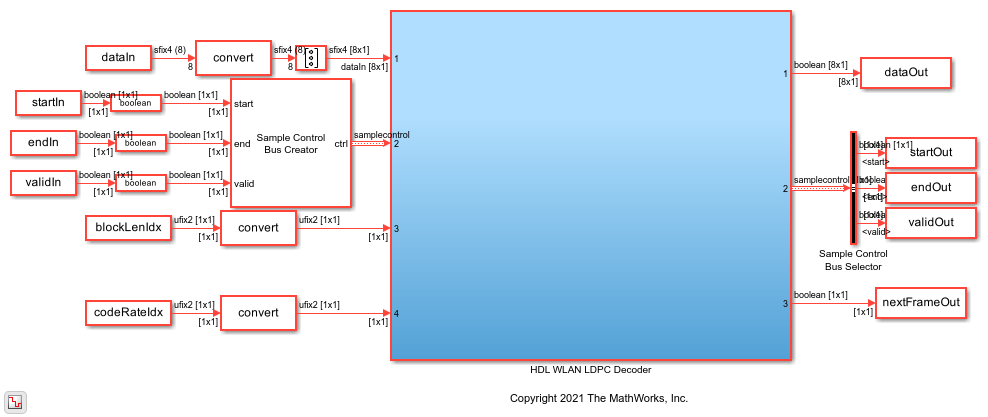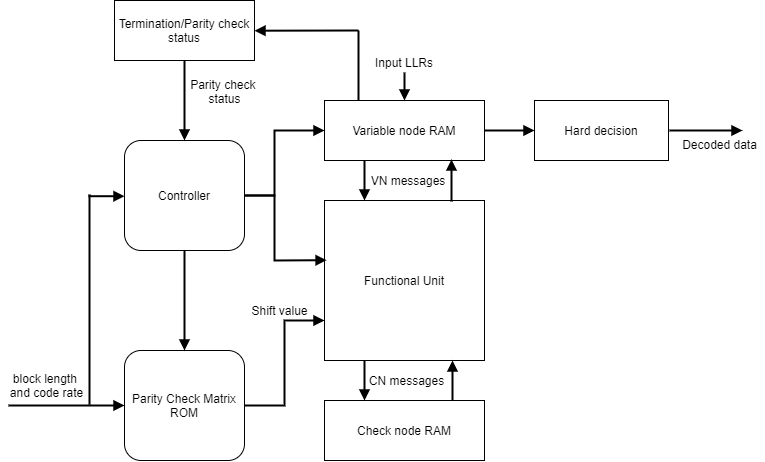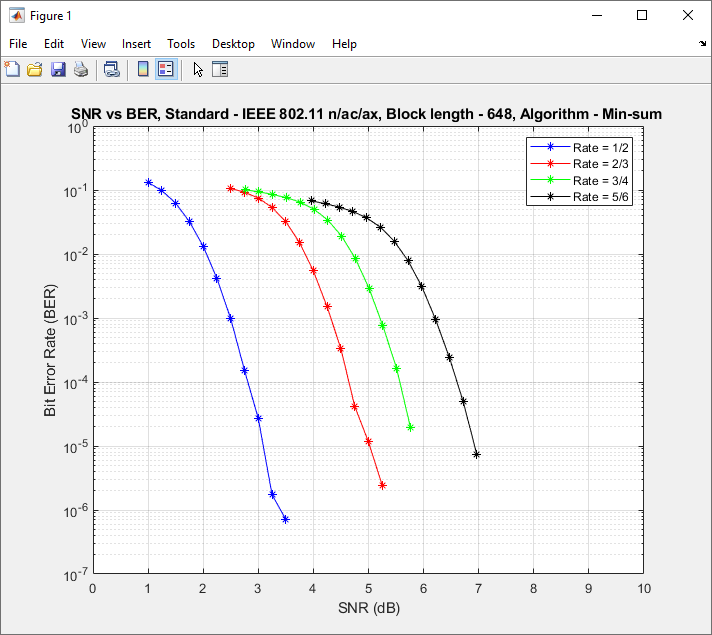WLAN LDPC Decoder
Libraries:
Wireless HDL Toolbox /
Error Detection and Correction
Description
The WLAN LDPC Decoder block implements a low-density parity-check (LDPC) decoder using a layered belief propagation with min-sum approximation and normalized min-sum approximation algorithms for decoding LDPC codes according to the wireless local area network (WLAN) standards IEEE® 802.11n™, 802.11ac™, 802.11ax™, and 802.11ad™. The block accepts log-likelihood ratio (LLR) values, a stream of control signals, a block length, and a code rate as inputs and outputs decoded bits, a stream of control signals, and a signal that indicates when the block is ready to accept new inputs.
The WLAN LPDC Decoder block supports scalar inputs and vector inputs. The block supports early termination to help improve decoding performance and convergence speeds at high signal-noise-ratio (SNR) conditions. For more information about WLAN standards, see [1], [2], and [3].
The block provides an architecture suitable for HDL code generation and hardware deployment. You can use this block in the WLAN modem development.
Examples
Ports
Input
Output
Parameters
Algorithms
References
[1] IEEE Std 802.11™-2016 (Revision of IEEE Std 802.11-2012). “Part 11: Wireless LAN Medium Access Control (MAC) and Physical Layer (PHY) Specifications.” IEEE Standard for Information technology — Telecommunications and information exchange between systems. Local and metropolitan area networks — Specific requirements.
[2] IEEE STD 802.11ad-2012 (Amendment to IEEE Std 802.11-2012, as amended by IEEE Std 802.11ae™-2012 and IEEE Std 802.11a™-2012). “Part 11: Wireless LAN Medium Access Control (MAC) and Physical Layer (PHY) Specifications. Amendment 4: Enhancements for Very High Throughput Operation in Bands below 6 GHz.” IEEE Standard for Information technology — Telecommunications and information exchange between systems. Local and metropolitan area networks — Specific requirements.
[3] IEEE Std 802.11ah™-2016 (Amendment to IEEE Std 802.11-2016 as amended by IEEE Std 802.11ai™-2016). “Part 11: Wireless LAN Medium Access Control (MAC) and Physical Layer (PHY) Specifications. Amendment 2: Sub 1 GHz License Exempt Operation.” IEEE Standard for Information technology — Telecommunications and information exchange between systems. Local and metropolitan area networks — Specific requirements.
[4] Gallager, R. “Low-Density Parity-Check Codes.” IEEE Transactions on Information Theory 8, no. 1 (January 1962): 21–28. https://doi.org/10.1109/TIT.1962.1057683.
[5] Hocevar, D.E. “A Reduced Complexity Decoder Architecture via Layered Decoding of LDPC Codes.” In IEEE Workshop OnSignal Processing Systems, 2004. SIPS 2004., 107–12. Austin, Texas, USA: IEEE, 2004. https://doi.org/10.1109/SIPS.2004.1363033.
[6] Chen, Jinghu, R.M. Tanner, C. Jones, and Yan Li. "Improved min-sum decoding algorithms for irregular LDPC codes." In Proceedings. International Symposium on Information Theory, 2005. ISIT 2005. https://doi: 10.1109/ISIT.2005.1523374.
Extended Capabilities
Version History
Introduced in R2021b





